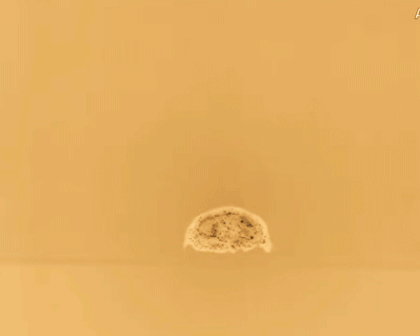If you want to make trinitite, all you need is a few things: a bucket of sand and the intense heat of a thermonuclear weapon. Scientists first noticed this strange green-red glass after dropping some of the very first atomic bombs in the dying days of War World Two. As it turned out, this material was even stranger than they first realized.
In the early morning of July 16, 1945, the world’s first atomic bomb was detonated near Alamogordo in the dusty desert of New Mexico, shooting an 11,500-meter (~38,000-foot) mushroom cloud into the air. When the blast site was investigated, people noticed that a never-before-seen glassy material had been left behind like residue.
They called it trinitite after the code name for the first atomic bomb blast, Trinity, although it also goes by the name Alamogordo glass. It’s largely made of silicate dioxide embedded with melted quartz grain and feldspar, as well as a sprinkling of other minerals like calcite, hornblende, and augite.
Trinitite was formed by sand that had been melted by the unbelievable amount of heat energy kicked out by the bomb. By one estimate, it rose the air temperature at its core to approximately 4,982 degrees Celsius (9,000 degrees Fahrenheit). The blast would have sprayed heaps of sand into the sky, cooking it in an atomic fireball, before letting into rain down as a liquid. Once it reached the ground, it cooled and formed this crystal-like glass.

Trinitite can feature an array of colors – namely grey, green, and red – and it’s been speculated that each hue is caused by the different materials in the bomb itself, as well as the various radionuclides formed during the detonation. Green trinitite may have been formed by material from the bomb’s shell, while red trinitite may stem from copper electrical wiring.
As such, scientists have floated the idea of using trinitite as forensic evidence to understand the composition and origin of nuclear bombs.
Similar melted glass materials can be naturally made with other displays of fierce energy, such as meteorites and lightning strikes, but trinitite is characterized as its own district material that’s only created by atomic bomb blasts.
It’s considered mildly radioactive, although not enough to cause too much concern. Trinitite could even be found at the Trinity site as late as 2018, despite the clean-up efforts of the US Atomic Energy Commission that bulldozed the area in the 1950s.
In yet another strange twist to the tale of trinitite, scientists have recently discovered that it has an extremely unusual atomic structure containing “forbidden” quasicrystals.
A typical crystal refers to a material that has atoms that are symmetrically ordered in a periodic, repeating pattern. However, quasicrystals have atoms that are still ordered but the pattern is not repeated. This results in a bizarre asymmetric and non-repeating atomic structure that’s not seen in typical crystals and is known as “forbidden symmetry“.
Quasicrystals are known to be formed by meteorites and in labs, but it appears that atomic blasts also pack enough punch.
When quasicrystals were first identified in the 1980s by Daniel Shechtman, an Israeli materials scientist, he was showered with criticism and mockery, but his discovery eventually landed him the 2011 Nobel Prize in Chemistry.
Source Link: Trinitite Is Atomic Rock Forged By The Fireballs Of Nuclear Bombs